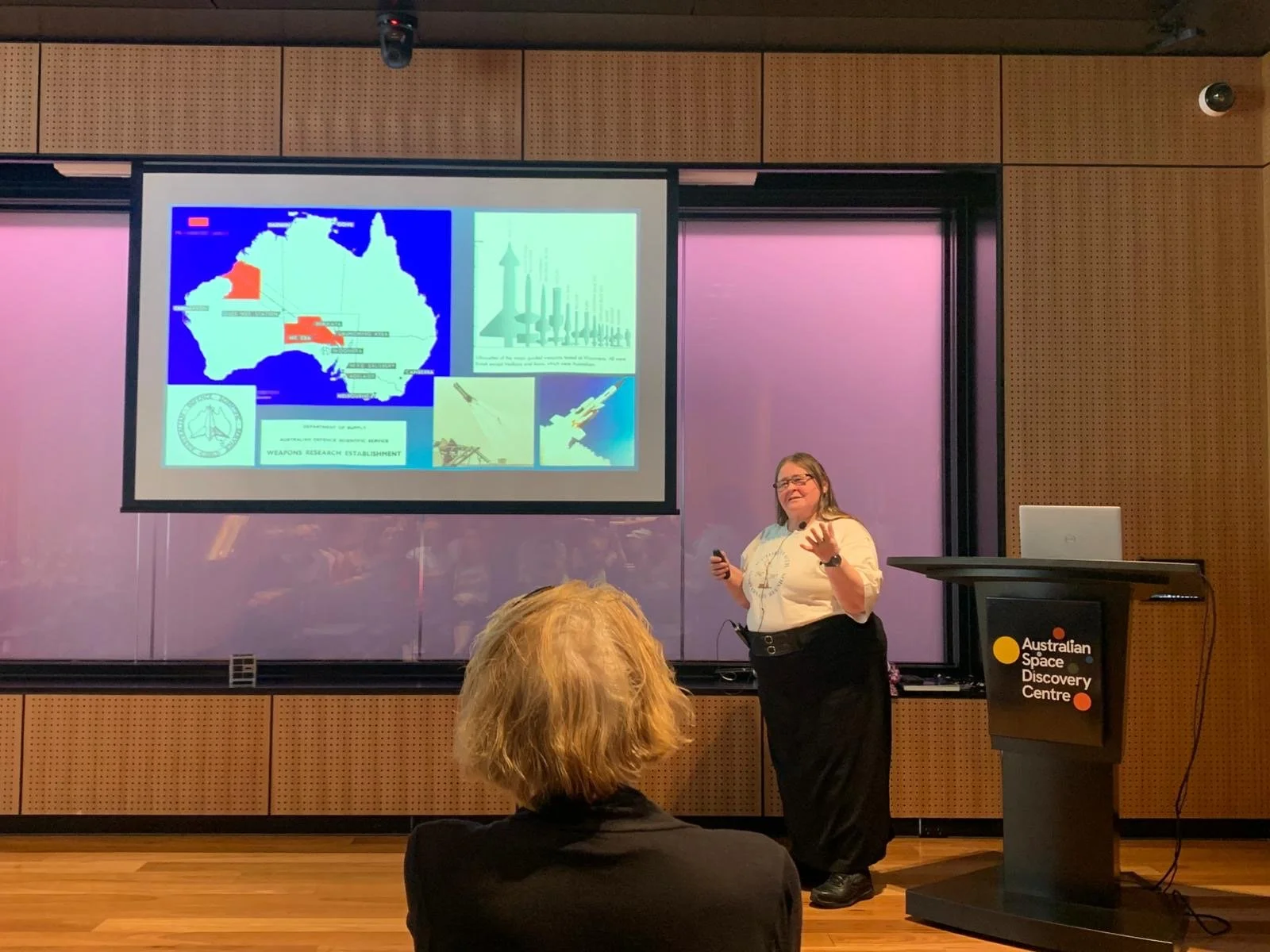How South Australia Became the ‘Space State’
“There were over 100,000 visitors to the Australian Space Discovery Centre (ASDC) in the first three years since opening,” Kerrie Dougherty OAM kicked off with this remarkable figure in the ASDS’s ‘Decisions that Launched South Australia into Space' recent webinar, 04/05. This insightful note foreshadowed her following presentation of stepping through the history that led South Australia to be considered the ‘Space State.’
As a Space Historian, Dougherty’s engaging talk covered the earliest decisions - starting with the Woomera Range Complex (WRC), originally a long-range weapon testing facility since 1947, that then became a widely known site for space activity in 1957. The WRC location on the Arcoona Plateau was sufficient for its early purpose as a weapons testing facility and was an ideal location for space activity due to its open range and minimal population (Island Lagoon Station intro 2025) (Ericsson 2018).
Dougherty continued through the history of space in South Australia, touching on the foundation that the Commonwealth Scientific and Industrial Research Organisation (CSIRO) laid. The collaborative groups that CSIRO established, contributed to early South Australia’s space efforts as they were involved in the development of radio astronomy, earth observations and space tracking (Ward 2015).
Another key step Dougherty highlighted, was the International Geophysical Year (IGY) between 1957 and 1958. This year was key for the global contribution of data to study Earth and its relationship to space (Trove 2025). Not far from the Woomera township, South Australia’s first tracking station was formed in 1957 at Woomera Range G, which began the future of Australia’s involvement in space tracking (Dougherty & Sarkissian n.d.) (Island Lagoon Minitrack 2025) (Island Lagoon Minitrack 2025b). Range G relied on the cooperation of people to function the station, this included but wasn’t limited to the groups of amateur astronomers that were recruited to observe the satellites’ position with the naked eye. They achieved this by viewing the sky at dawn and dusk, the sweet spot for viewing satellites. Amongst the darkened sky, the satellites are highlighted by the sun as they sit in orbit (NASA n.d.), this allowed astronomers to view the them as faint dots tracking across the sky and hence locate exactly where they are and map their future path.
These early efforts to involve Australia in space tracking paid off - as almost a decade after the IGY, Woomera yet again drew attention to South Australia as they launched Australia’s first satellite, the Weapons Research Establishment Satellite (WRESAT1), into orbit. Designed, built, and launched in only 11 months, WRESAT1 was a joint partnership between The University of Adelaide and the Weapons Research Establishment (WRE) (de Zwart n.d.). This milestone marked a huge achievement for Australia, as only the third country to launch a satellite from its own soil (Ericsson 2018) (WRESAT — Weapons Research Establishment Satellite 2012).
In more recent years, Adelaide, the capital of South Australia, has become the centre of Australia’s space sector - with the Australian Space Agency (ASA), Mission Control Centre (MCC), and the ASDC, all established in the city as a recognition of continued commitment to contributing to the space industry. In 2018 ASA was announced to be housed at Lot Fourteen, followed by the MCC in 2019 (About SASIC n.d.). The ASA officially opened doors in 2020, with both the ASDC and MCC in operation from 2021 (Australian Space Agency opens in Adelaide | Australian Space Agency 2025). With startups, researchers and government groups collaborating to drive Australia’s space sector, a state that was once initially chosen for its remoteness is now bustling with space activity.
Australia has come a long way from the early decisions that launched South Australia into space. Dougherty, author of ‘Space in Australia’, has discussed this history in depth, through both her insightful book and enlightening talk at the ASDC. Her knowledge sheds light on the unique pathways paved, highlighting key decisions that shaped the industry as we see it today which led South Australia to be considered the ’Space State’.
-
About SASIC n.d., SASIC.
Australia in Space - ATF Press 2017, ATF Press - A Publishing House and On-Line Book Store, viewed 30 May 2025, <https://atfpress.com/product/space-in-australia/>.
Australian Space Agency opens in Adelaide | Australian Space Agency 2025, Space.gov.au, viewed 30 May 2025, <https://www.space.gov.au/news-and-media/australian-space-agency-opens-adelaide>.
de Zwart, M n.d., Melissa de Zwart*.
Dougherty, K & Sarkissian, J n.d., Dishing up the Data: the role of Australian space tracking and radio astronomy facilities in the exploration of the Solar System, viewed 30 May 2025, <https://www.parkes.atnf.csiro.au/people/sar049/papers/JMS_08.pdf>.
Ericsson, K 2018, Woomera: Where it all began, Melbourne Space.
Island Lagoon Minitrack 2025a, Honeysucklecreek.net, viewed 30 May 2025, <https://honeysucklecreek.net/other_stations/island_lagoon/minitrack.html>.
Island Lagoon Minitrack 2025b, Honeysucklecreek.net, viewed 30 May 2025, <https://honeysucklecreek.net/other_stations/island_lagoon/minitrack.html>.Island Lagoon Station intro 2025, Honeysucklecreek.net, viewed 30 May 2025, <https://honeysucklecreek.net/other_stations/island_lagoon/Island_Lagoon_intro.html>.
NASA n.d., Skywatching - NASA Science, science.nasa.gov.
Trove 2025, Nla.gov.au, Trove, viewed 30 May 2025, <https://trove.nla.gov.au/people/1491621?c=people>.
Ward, C 2015, Astronomy, Space Science, Information and Communication Technology Divisions - CSIROpedia, CSIROpedia, viewed 30 May 2025, <https://csiropedia.csiro.au/astronomy-and-space-science-2009/>.
WRESAT — Weapons Research Establishment Satellite 2012, Defence.gov.au.


